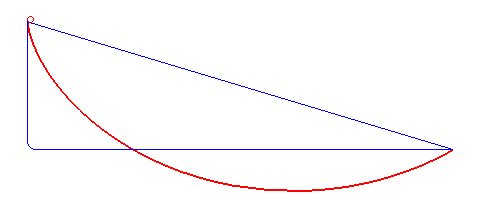Beltrami identity on:
[Wikipedia]
[Google]
[Amazon]
The Beltrami identity, named after
"Euler-Lagrange Differential Equation."
Fro
MathWorld
-A Wolfram Web Resource. See Eq. (5).Thus, the Legendre transform of the Lagrangian, the
 An example of an application of the Beltrami identity is the
An example of an application of the Beltrami identity is the
 Consider a string with uniform density of length suspended from two points of equal height and at distance . By the formula for arc length,
where is the path of the string, and and are the boundary conditions.
The curve has to minimize its potential energy
and is subject to the constraint
where is the force of gravity.
Because the independent variable does not appear in the integrand, the Beltrami identity may be used to express the path of the string as a separable first order differential equation
where is the
Consider a string with uniform density of length suspended from two points of equal height and at distance . By the formula for arc length,
where is the path of the string, and and are the boundary conditions.
The curve has to minimize its potential energy
and is subject to the constraint
where is the force of gravity.
Because the independent variable does not appear in the integrand, the Beltrami identity may be used to express the path of the string as a separable first order differential equation
where is the
Eugenio Beltrami
Eugenio Beltrami (16 November 1835 – 18 February 1900) was an Italian mathematician notable for his work concerning differential geometry and mathematical physics. His work was noted especially for clarity of exposition. He was the first to ...
, is a special case of the Euler–Lagrange equation
In the calculus of variations and classical mechanics, the Euler–Lagrange equations are a system of second-order ordinary differential equations whose solutions are stationary points of the given action functional. The equations were discovered ...
in the calculus of variations
The calculus of variations (or variational calculus) is a field of mathematical analysis that uses variations, which are small changes in Function (mathematics), functions
and functional (mathematics), functionals, to find maxima and minima of f ...
.
The Euler–Lagrange equation serves to extremize action functionals of the form
:
where and are constants and .
If , then the Euler–Lagrange equation reduces to the Beltrami identity,
where is a constant.Weisstein, Eric W"Euler-Lagrange Differential Equation."
Fro
MathWorld
-A Wolfram Web Resource. See Eq. (5).Thus, the Legendre transform of the Lagrangian, the
Hamiltonian
Hamiltonian may refer to:
* Hamiltonian mechanics, a function that represents the total energy of a system
* Hamiltonian (quantum mechanics), an operator corresponding to the total energy of that system
** Dyall Hamiltonian, a modified Hamiltonian ...
, is constant along the dynamical path.
Derivation
By thechain rule
In calculus, the chain rule is a formula that expresses the derivative of the Function composition, composition of two differentiable functions and in terms of the derivatives of and . More precisely, if h=f\circ g is the function such that h ...
, the derivative of is
:
Because , we write
:
We have an expression for from the Euler–Lagrange equation,
:
that we can substitute in the above expression for to obtain
:
By the product rule
In calculus, the product rule (or Leibniz rule or Leibniz product rule) is a formula used to find the derivatives of products of two or more functions. For two functions, it may be stated in Lagrange's notation as (u \cdot v)' = u ' \cdot v ...
, the right side is equivalent to
:
By integrating both sides and putting both terms on one side, we get the Beltrami identity,
:
Applications
Solution to the brachistochrone problem
 An example of an application of the Beltrami identity is the
An example of an application of the Beltrami identity is the brachistochrone problem
In physics and mathematics, a brachistochrone curve (), or curve of fastest descent, is the one lying on the plane between a point ''A'' and a lower point ''B'', where ''B'' is not directly below ''A'', on which a bead slides frictionlessly under ...
, which involves finding the curve that minimizes the integral
:
The integrand
:
does not depend explicitly on the variable of integration , so the Beltrami identity applies,
:
Substituting for and simplifying,
:
which can be solved with the result put in the form of parametric equation
In mathematics, a parametric equation expresses several quantities, such as the coordinates of a point (mathematics), point, as Function (mathematics), functions of one or several variable (mathematics), variables called parameters.
In the case ...
s
:
:
with being half the above constant, , and being a variable. These are the parametric equations for a cycloid
In geometry, a cycloid is the curve traced by a point on a circle as it Rolling, rolls along a Line (geometry), straight line without slipping. A cycloid is a specific form of trochoid and is an example of a roulette (curve), roulette, a curve g ...
.This solution of the Brachistochrone problem corresponds to the one in —
Solution to the catenary problem
Lagrange multiplier
In mathematical optimization, the method of Lagrange multipliers is a strategy for finding the local maxima and minima of a function (mathematics), function subject to constraint (mathematics), equation constraints (i.e., subject to the conditio ...
.
It is possible to simplify the differential equation as such:
Solving this equation gives the hyperbolic cosine, where is a second constant obtained from integration
The three unknowns , , and can be solved for using the constraints for the string's endpoints and arc length , though a closed-form solution is often very difficult to obtain.
Notes
References
{{reflist Calculus of variations Optimal control